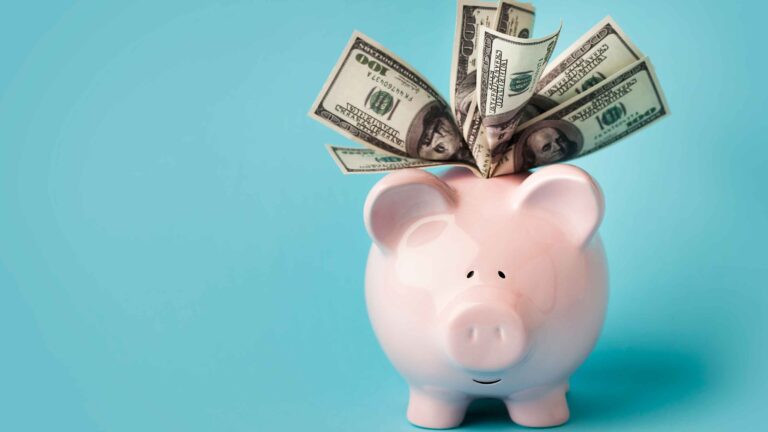Last updated Feb. 14, 2023 by Peter Jakes
We are constantly bombarded with scary money statistics that make us fearful, anxious, and confused. This is especially true in financial situations. What are we supposed to do with our money? What is everyone else doing with their money? Are we losing ground? Are we just another number?
Americans are preoccupied with anxiety and constant financial stress. Don’t let money become another source of stress in your life.

Statistics are useful and give us a better understanding and precise descriptions of events. But, unfortunately, you, as a human, have unknowingly contributed to certain statistics.
Although these statistics have no overall impact on your life, it is beneficial to be informed about some frightening money statistics you do not want to be a part of. So please take a look at them below!
Related: Signs You Don’t Make Enough Money? Here’s What to Do
Savings and Retirement Statistics #1
One-third of Adults in the United States Don’t Have any Savings Set up for Retirement
According to a poll by GoBankingRates, an outstanding one-third of American adults have practically no savings for their Retirement. In addition, many Americans are surviving paycheck to paycheck; thus, they have little money left for savings.
Although the legal age for Retirement in the United States is 62, a recent survey carried out by NerdWallet reveals that most graduates will not contemplate the idea of Retirement until they reach the age of 75. In addition, many more ask how much is enough for Retirement.
Women are even more at risk because they earn less than men, live longer, and have less money to invest. About two-thirds of women, or 63%, say they have no savings or less than $10,000, while only 52% of men say the same.
Because women save and invest much less for Retirement than men, this could add up to $1 million. Age is also closely linked to how much you have saved for Retirement.
Millennial and Retirement
Since they just started working, Millennials are the least likely to have a big retirement fund. For example, 42% of millennials say they don’t have any money saved for Retirement. On the other hand, 30% have less than $10,000 saved, and 28% have more than $10,000 saved.
For most Americans, what does this mean? Maybe the trouble of starting a retirement fund is enough to make you decide not to do it. People may not want to open a retirement savings account because they don’t know how to plan for it, the future seems to be getting worse, and it’s hard to move money from one job to another.
But there are a lot of scary things that can happen if you don’t save for Retirement or take the necessary steps 10 years before retirement. This is one alarming statistic that you could be part of! Retirement might feel like it’s a long way off when you’re young, but it isn’t!
So start making plans for your Retirement.
Students Loan Statistics #2
40% of Student Loan Borrowers are Expected to Go Into Default by 2023.
Education debt in the United States has tripled in the last ten years and now stands at more than $1.5 trillion. And the future looks worse and worse for people who have student loans.
When you borrow money from a lender, you agree to pay it back according to certain rules. If you don’t pay your loan on time, you may be loan delinquent. When a borrower doesn’t pay back a loan, this is called “loan default,” and the loan amount is sent to a collection agency. Depending on the terms of your loan and state or federal laws, you may default immediately or after missing payments for a few months.
Nearly one in four students who took out loans for college leave without paying them back within four years or taking steps to learn how to refinance students loans and save thousands for themselves. That’s more than a million students every year.
In just two years, 29% of students with federal student loans and 19% of those with private loans are behind on their payments. By 2023, nearly 40% of those who took out student loans are expected not to pay them back.
What are the Implications?
This isn’t surprising when you think about how uncertain job prospects are and how unstable life can be after college. In addition, borrowers may be struggling financially and unable to repay their student loans.
Even worse, people whose late payments get a big hit on their credit scores. The average credit score of people who haven’t paid back their student loans is 550, which is right on the edge of “subprime” credit. On the other hand, good-standing borrowers have average scores in the high 600s.
People with low credit scores usually have to pay higher interest rates, have trouble renting, buying homes later or not, and may even be turned down for some jobs. In addition, if a student loan borrower doesn’t pay back their loan, collection fees and interest will add to their debt.
Other bad things that can happen if you don’t pay your student loans are wage garnishments, tax offsets, suspension or revocation of state-issued professional licenses, and suspension of your driver’s license.
People who don’t pay back their student loans are more likely to live in Hispanic and black neighborhoods. Also, people of color have more student loan debt than white people. This is partly because their families have less money and are more likely unemployed.
Emergency Funds Statistics #3
61% of Americans don’t have enough savings to cover a $1,000 emergency.
Anyone can have trouble at any time, whether it’s a health problem, a car repair, or a job loss. Did you know that if you don’t have insurance, an ambulance ride can cost more than $1,000 and even up to $2,000? Or that most car repairs cost between $500 and $600?
Even scarier is that most Americans don’t have the money to cover these unexpected costs. A Bankrate survey found that 34% of American households had an unanticipated high cost in the past year, but only 39% of respondents said they could cover a $1,000 bill with their savings.
By having to rely on credit, loans, and borrowing money, it’s clear that a large portion of the population is budgeting for the short term, if at all. Even though it’s hard to plan for the future, especially since many Americans live paycheck to paycheck and focus on meeting their basic needs, everyone needs an emergency fund, which can give them financial security and lessen their worries.
Savings Account Statistics #4
Only 21% of Adults in the United States Have a Bank Account
These statistics may come off as fake, but it is true! A poll by GoBankingRates researched over 5000 organizations and found over 21% of American adults do not own a basic savings account.
Another Federal Deposit Insurance Corp survey also discovered that over 25% of Americans are unbanked or underbanked. Although this percentage of people do not use a bank, it is found that they use financial services other than the banking system.
Some people do not have enough money to save in a bank, while the rest do not trust a bank to keep their money. Therefore, it is important to learn how to open a savings account.
It takes just a few minutes to open a bank account. If you can’t find a physical bank close to you, then open an online FDIC-insured bank. Obtain one and make it a practice to save a part of your income, even if it’s only a few dollars now and then. The most important thing is to incorporate savings into your weekly or monthly activities.
Statistics #5
Financial Concerns Continue to Plague the Lives of 64% of Americans
Have you ever stressed about your financial status? According to research carried out by American Psychological Association (ASA), you are not the only one in this situation.
A staggering 64% of Americans are anxious about their financial life. This percentage includes both the poor and the rich. More polls have shown that feeling stressed about money affects people of all income levels. Learn to Accept Your Financial Situation and stop bad spending habits.
Life is full of ups and downs. Unfortunately, you can’t always have what you hope for. So learn to accept that your financial status may never get you all you wish for.
Credit Card Statistics #6
38% of U.S. Households Have Credit Card Debt.
It is estimated that an average American household owes a remarkable amount of $15,310 in credit card debt. The total credit card debt in the United States amounts to $712 billion. What is your credit score? If you have a credit card debt of over $1000, you are probably part of this statistic.
All kinds of debt are a big problem in the United States, and by the end of 2018, consumer debt is expected to reach $4 trillion. People spend more than they can afford when their wages are low, and the cost of living is high.
The Federal Reserve Bank of New York said that credit card balances went up to $26 billion in the last three months of 2017. Credit cards, when used in a good way, can open the door to a new level of business independence. However, when used incorrectly, it leads you into a cycle of debt.
Credit is like a sword with two edges
It can be used to buy things that will help build wealth, but it can also lead to too much debt and interest that keeps adding up.
Credit cards are the most common form of credit, and a simple rule for using them responsibly is not to buy anything you couldn’t pay for with cash. (Of course, there are rare exceptions, like when there’s an emergency.) Don’t think of credit cards as a way to get into more debt. Instead, think of them as plastic cash.
Don’t buy something on credit if you won’t be able to pay it off in a reasonable amount of time. Likewise, do not seek a credit card loan unless you are financially stable to pay it off. Various content and guides on the internet can help you reduce your credit card loan.
Paycheck Statistics #7
More than half of all Americans are Surviving from Paycheck to Paycheck
Statistics have shown that millions of Americans are surviving only from paychecks. Do you know that half of Americans don’t have $250 to spare? A recent article by The Guardian revealed that wealthy Americans are also part of the millions surviving from paychecks.
This shows how important it is to cultivate the habit of saving. One way to remove yourself from these statistics is to cultivate a frugal lifestyle. Another way is to look for an additional source of income that prevents you from running out of money.
Statistics #8
Throughout Their Lives, Smokers Will Shell Out Between $1 to $2 Million
If you are a smoker, this is a statistic you are part of. According to studies conducted by the American Lung Association, a cigarette addict will spend a significant amount of his life’s wealth on cigarettes.
This study further stated that smokers spend over one million dollars on cigarettes. Research conducted by the National Cancer Institute says a pack of cigarettes costs $6.28 on average. So, if you consume a pack daily, you’ll spend roughly $188 per month or $2,292 per year. This is a huge amount when multiplied by your years of smoking.
Ending a smoking addiction is one of the hardest things to do. But doing it brings a lot of benefits. Not only do you save money, but you also save your health from complications that arise from smoking. The internet provides various tips on how to end a smoking addiction. Look it up!
A site that provides useful tips is “SmokeFree.gov.” This site provides support, strategies, daily challenge, and more.
Statistics #9
30% – 40% of the Entire Wheat Supply in the United States Is Lost to Waste
According to WorldFoodDayUSA.org, the United States wastes over 40% of its food supply. If you have ever thrown away a fresh food product, you are one of the reasons for this scary statistic.
One of the most effective ways to reduce these scary statistics is by creating a food budget. Always plan each meal and grocery you shop for.
Other Interesting Scary Money Statistics You Should know about and Avoid
1. Among adults who have combined finances in current or previous relationships, 2 out of 5 fess up to committing financial infidelity, according to the National Endowment for Financial Education.
In any relationship where people share money, it’s important to be open and honest about money. It can help ensure you’re on track to reach your financial goals and stick to a shared budget. Couples can manage their money together, from putting everything in one account to keeping everything separate.
Some couples get along well when they do most things together but agree on a no-judgment allowance for spending on things they want. So if it’s important for you to have separate accounts in a relationship or if you want little spending money that you don’t want to be responsible for, just set some limits with your spouse.
Coming to an understanding of how to save money, like cutting back on take-out, cheap Stay-at-home date ideas, and saving more on utilities, could help.
2. Social Security benefits total less than $20,000 per year.
Are you considering relying on Social Security for Retirement? Consider again. In September 2022, the average Social Security payment would be $1,547 per month. 2 That’s just over $18,500 per year. Do you believe that will be sufficient for your Retirement? Neither do we. The Social Security Administration has stated that Social Security is not intended to replace your entire income.
3. According to the Global Financial Literacy Excellence Center, almost half of student loan holders express concern about their ability to pay off their student debt.
For people who have taken out student loans, the sheer amount of debt can make them scared and unsure about how they will ever pay it back. However, most of us now learn about money when we make a mistake with something as important as student loans. Federal student loan borrowers can look into repayment plans like income-based repayment, which may lower their monthly bills, and work with their student loan servicers to change their repayment schedule.
4. 34% of Americans don’t believe they will ever recover financially from the pandemic.
The pandemic had a devastating mental and financial impact on many people. So it’s no surprise: more than half of Americans live paycheck to paycheck, with no emergency fund to fall back on in times of need. Moreover, according to Ramsey Solutions research, more than a third of Americans do not believe they will recover.
5. Almost half of all Americans lose sleep over money.
Ramsey’s research also discovered that nearly half of all Americans lose sleep over money. A scary movie marathon is the only thing that should keep you awake at night. However, you can sleep well if you’re on track with your plan to accumulate wealth for Retirement. Unfortunately, we’re more concerned about the half of Americans who don’t worry about Retirement. This indicates that many people ignore the problem and refuse to think about it.
6. Only 24% of millennials demonstrate basic financial literacy, according to a study from the National Endowment for Financial Education.
This number is even more problematic when you consider that 69% of the millennials surveyed gave themselves high marks for their financial knowledge, according to a study done with the Global Financial Literacy Excellence Center at George Washington University.
Figure out what you did wrong with your money and learn from it. Personal finance is a trial-and-error exercise. We won’t get better at it if we don’t first see where we’re going wrong.
7 . One-third of all Americans have no retirement savings.
Saving in general, and saving for Retirement in particular, deserves special attention. According to a Bankrate survey, 33% of Americans have no retirement savings.
According to the survey, 56% saved less than $10,000 for Retirement. Aside from that, 33% of Americans have no retirement savings.
- The S&P 500 fell 25.2% in September. (The Carson Group)
- In August, the Consumer Price Index rose 8.3% year on year, not seasonally adjusted (NSA). Furthermore, the index for all items excluding food and energy, increased by 0.6% in August (S.A.) and is up 6.3% year on year (NSA). (From the United States Bureau of Labor Statistics)
- On October 6, 2022, the current average mortgage rate for a 30-year loan was 6.89%, the highest level since November 2008. (Bankrate)
- 56% of workers expect less than $500,000 saved for Retirement, with 36% expecting less than $250,000 saved. (PlanSponsor)
- Only about two-thirds of adults could pay a hypothetical $400 bill in cash or its equivalent. Federal Reserve (Federal Reserve)
- 44% of retirees reported that their retirement expenses were higher than expected (PlanSponsor)
- 37% have not planned anything. (PlanSponsor)
- 51% of American adults have delayed at least one major life decision for financial reasons in the last year, up 20% from a similar survey conducted in 2007. (CPA Practice Consultant)
- 24% of consumers have no emergency savings. (Financial Consumer Protection Bureau)
How Can You Avoid Becoming the Next Unfortunate Financial statistic?

- Start Contributing to your retirement savings.
While high-interest rates and inflation have made it more difficult for people to save for short and long-term goals, saving for Retirement is a critical building block for maintaining your lifestyle when you’re no longer working. The longer you wait to start saving for Retirement, the less money you may have when you retire. This is significant because, in Retirement, Social Security only replaces about 40% of the average worker’s pre-retirement income. Even if you intend to work later in life to supplement Social Security and a pension (if you have one), circumstances beyond your control, such as illness, injury, or layoff, may force you to change your plans.
Fortunately, time is always on your side when saving money. Because of tax-deferred compounding, this is especially true when you save through a qualified retirement plan, such as a 401(k), 403(b), or individual retirement account (IRA). In addition, because account earnings are not taxed until they are distributed, which is usually in Retirement, your retirement account investments have the potential to grow even faster than comparable taxable investments.
Ideally, you want to maximize your savings potential by contributing the maximum annual amounts to any plans in which you are eligible, including catch-up contributions once you are eligible.
● Begin saving right away.
If you don’t already have an emergency savings fund, start one now. An emergency fund serves as a safety net for dealing with unanticipated expenses. For example, it can assist you in avoiding high-interest credit card debt or dipping into long-term assets. Market fluctuations may consequently impact this in the event of a job loss, health crisis, costly car repair, or other unexpected expenses.
Most financial experts recommend that your emergency savings account cover at least six months of current living expenses. Even if you can only save a small amount each month, making savings a habit is more important than the initial amount you set aside.
● Maintain a low credit card balance.
Minimize credit card debt and stick to the 30% utilization rule—we all know it. Maxing out a credit card or coming close and not paying it off each month almost always lowers credit scores.
Reduce unnecessary spending, cut back on bad spending habits that hinder your wealth building and possibly borrow from a retirement account or emergency fund to quickly pay off credit card debt. For those making minimum payments each month, the accrued interest could cost hundreds or thousands, so prioritize payments by higher interest balances.
Last, pay on time. The three major credit card bureaus—TransUnion, Experian, and Equifax—will report delinquent accounts. Creditors may close and send severely delinquent accounts to collections.
Debt-ridden people are not alone. Contact your creditor, financial advisor, or other trusted sources about your situation. Creditors may offer payment plans or lower interest rates. You can improve with a plan and commitment.
● Start Budgeting.
Budgeting is one of the most effective methods for reducing spending to save more money. Even if you can only find an extra $5 per day, that adds up to $1,825 in savings over a year, and thanks to rising interest rates, you may even earn more on cash now. A budget is also important for managing existing debt and avoiding new debt. As you pay down existing debt, redirect your monthly payments to short-term and long-term savings, and Lear to put your savings on autopilot for more disciplined savings.
● Don’t be afraid of the (market) reaper.
While bonds have historically performed well when stocks have underperformed, this has not been the case in 2022. Instead, bonds (as measured by the Bloomberg U.S. Aggregate Bond Index) gained every time the S&P 500 fell 10% or more for the year, rising 7.7% on average. While that may not feel good, it’s important to remember that the stock market is only concerned with what comes next, not what happens.
● Create an Emergency Fund
An emergency fund provides a safety net to cover unexpected expenses without using high-interest debt like credit cards or predatory loans. As a result, an emergency fund reduces your risk of bankruptcy or debt.
While difficult, you are saving money while paying bills, reducing credit card or student loan debt, and achieving other financial goals is possible and necessary. It may require careful planning and sacrifice. End daily takeout. Starting now is best. Start saving $1 a day if you have nothing. $365 after a year. After a year, saving $5 daily yields $1,825 in savings.
Direct deposit a portion of your paycheck to a savings account or set a monthly reminder to “pay yourself first” by transferring funds from a primary account to savings. Financial experts advise starting with a $1,000 emergency fund. It will help you understand your monthly income and expenses and save money. Next, create a $2,000 emergency fund after establishing a cushion. Save more from there.
Save three to six months of your salary for unexpected expenses and job loss. This money will cover two months of living expenses while you find another job.
● Diversify Risk
That makes it even more important to stick with your current investment strategy, assuming it’s aligned with your goals, timeframe, and risk tolerance. You want to avoid selling at the bottom of a bear market, especially if stronger returns are likely in the near term. Selling at the bottom could greatly impact your investments for years to come.
Many investors have found that out the hard way in the past. By moving out of the market to avoid falling prices, they missed out on significant rallies as stocks eventually returned to new highs. Remember, the fourth quarter is historically the best quarter of the year, with the S&P 500 up 4.1% on average and nearly 80% of the time. While past performance is not indicative of future results, we believe stronger returns could be quite likely in the weeks and months ahead.
● Always have a financial plan.
A financial plan is your blueprint for accumulating and managing wealth. According to PlanSponsor, 91% of people with a written retirement plan say it has been helpful, with 33% saying it has been “critical” in putting them on a better path for Retirement. This is because a plan documents your goals and maps out a strategy to support them throughout your life. It also allows you to make changes as your needs change, your goals shift, and milestones are reached.
A well-thought-out strategy can help you resist the temptation to change your financial plan based solely on current market conditions. Instead, it’s designed to keep you on track regardless of market activity or changing economic conditions because it’s aligned with your short and long-term goals. This can go a long way toward reducing the fear and angst that volatility and uncertainty can cause, especially in a year like this one.
● Be Proactive with Students Loan Debt
Student loans and other debts require proactive management. There are a lot of ways to get rid of students loan debts fast. Explore grants, scholarships, and part-time jobs to reduce student loan debt. In addition, graduates should budget their repayment into monthly expenses. Finally, if you cannot repay your student loans, you have other options besides borrowing from family and friends.
Contact your student loan servicer ASAP. If you’re hesitant, ask your college’s financial aid office if they can help. Some staff can help students with everything from student loan advice to service provider phone calls.
An income-based repayment plan or a temporary deferment or forbearance may be better for you. Forbearance lets you stop paying student loans without accruing interest. Call your student loan servicer to find out how to get out of default. Loan rehabilitation, consolidation, or repayment are common options.
Loan rehabilitation is a one-time chance to get federal student aid and clear default. This nine- to 10-month program rehabilitates defaulted student loans by negotiating affordable repayment amounts with the lender. On-time payments remove borrowers’ default status from their accounts and credit history. Consolidating federal education loans allows for one monthly payment.
Related: 30 Budget Busters That Will Hinder Your Savings
Bottom Line
Fact is scarier than fiction. You might want to keep some of this information in mind the next time you pull a dollar bill. There are some surprising statistics at work, whether it is the money itself or the way we handle it. Understanding them ahead of time may be a good idea. Financial literacy is a major reason why Americans’ finances are in disarray.
Despite having the largest economy in the world, Americans rank 14th in financial literacy, according to Standard & Poor’s Global Financial Literacy Survey. Not the worst situation to be in, but troubling nonetheless.
And we all have unique stories and situations that have landed us in different financial situations. So the real question is, what are you doing to break the cycle and avoid becoming another worrying financial statistic? America has a lot of work to slow down these negative statistics, but taking more initiative in our finances, money, and budgeting is a great first step.
Frequently Asked Questions
Q: What is Financial Literacy
Financial literacy refers to comprehending and applying various financial skills, such as personal financial management, budgeting, and investing. Financial literacy is the foundation of your relationship with money and is a lifelong learning journey.
Q: What are the U.S. statistics on financial literacy?
Americans scored an average of 67.5% on the national financial literacy test. The current average score is 67.5%, and the percentage of failing scores is 57.5%. According to high school financial literacy statistics, the average score among Americans aged 15-18 in 2022 was 63.5%.
Q: What are interesting finance facts?
- If you invested $100 in Microsoft in 1986, it would be worth around $45,000 today!
- Google’s investments are worth more than the GDP of countries like Iraq.
- Goldman Sachs AUM is worth more than the GDP of Vietnam.
Q: How do I get myself out of the scary money statistics
No need to panic if you are already part of the scary statistics. Start saving now, create an emergency fund, reduce spending, repair your credit cards, and always make a budget.
Q: How do you avoid being scared out of your wits?
You must first examine your situation. How can you save automatically through a bank account or 401(k) plan if you aren’t saving? Then consider your debts. If you have credit card debt or a payday loan, pay those off first. In terms of interest payments, this is the most expensive. At the very least, mortgage debt is still partially deductible on your federal tax return.
Q: Is it Important to know these scary money statistics?
Financial statistics are useful because they can point us toward financial stability. Your finances must be organized to live a stress-free life and enjoy life more. After you’ve sorted out your day-to-day finances, you can learn how to start saving and improving your credit score.







